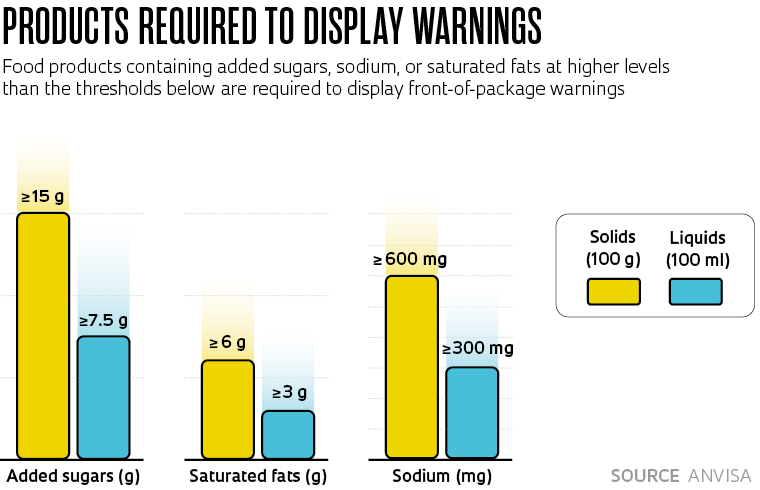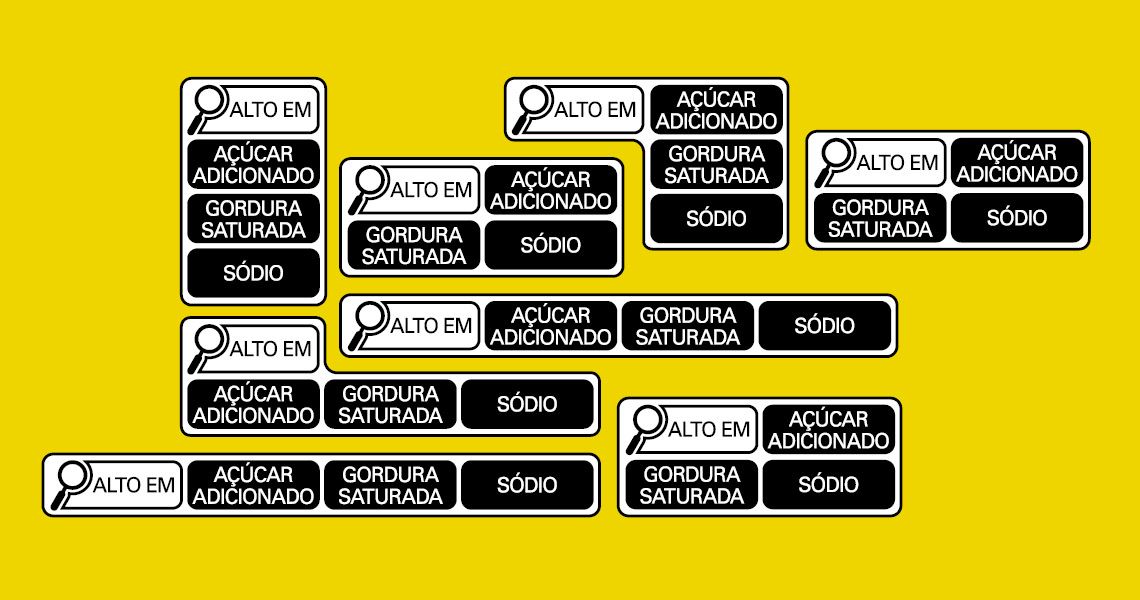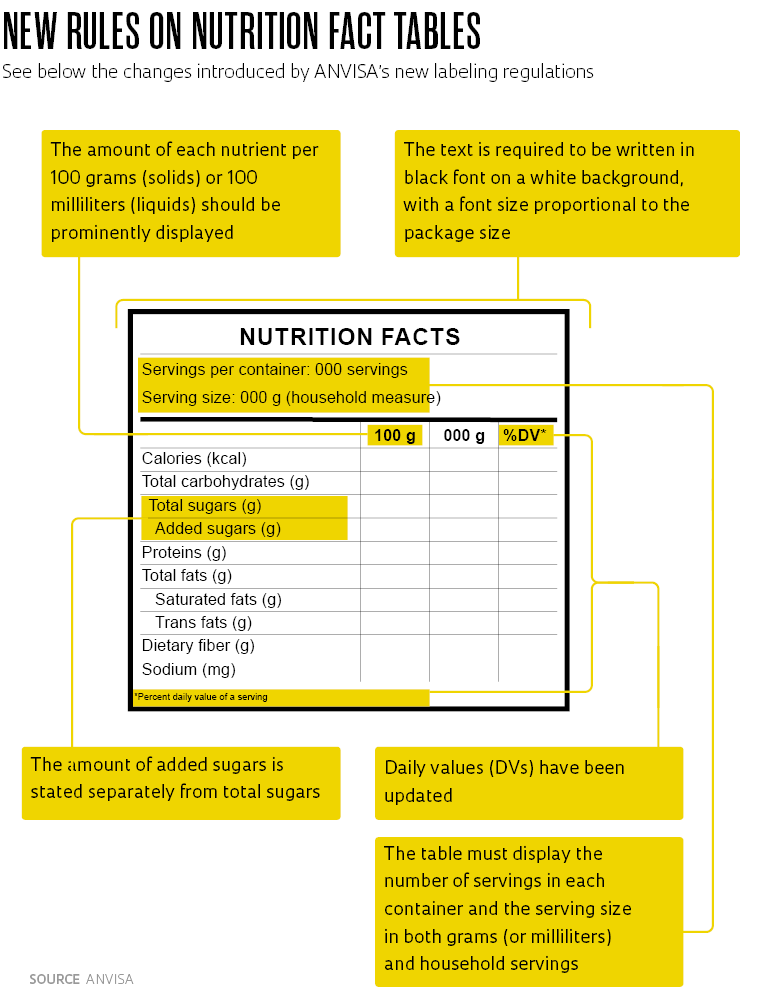On October 9, Brazilian consumers will notice a number of labeling changes on the food and beverage products they buy at supermarkets. The most noticeable change will be a front-of-package label showing any high quantities of three nutrients: added sugar, saturated fat, and sodium. This information is now required on all products, whether produced by large or by small food manufacturers. Where any food product contains at least one of the three nutrients at a level higher than the limit set by the Brazilian Health Regulatory Agency (ANVISA), the packaging is required to display a magnifying glass icon with the words “high in” followed by the one or more nutrients that are above the threshold (see chart). “The best available scientific evidence shows that high levels of these nutrients are associated with a higher prevalence of obesity and noncommunicable diseases, such as diabetes and heart problems,” says Tiago Rauber, head of ANVISA’s Food Standards and Regulations department.
The agency approved these and other labeling changes in October 2020 after six years of research and discussions involving representatives from the scientific community, the food and beverage industry, civil society, and the general public. Adding a conspicuous front-of-package warning is designed to help consumers readily and easily identify food products that are high in one or more of these nutrients without having to interpret the nutrition facts on the back side of the packaging—which will also see a number of modifications (see the infographic).
The changes will have immediate impacts. The new legislation establishes a grace period of just 12 months for manufacturers to ensure all products on the market are compliant with the new rules (all products launched after October 9 are required to be compliant). The grace period is 24 months for food products manufactured at small-scale facilities, small farms, and sole proprietorships. Nonalcoholic beverages sold in returnable packaging will have a grace period of 36 months. Failure to comply with the new rules constitutes a sanitary violation punishable by a warning, a fine, and a recall and destruction of the products involved.

Léo Ramos Chaves/Pesquisa FAPESP MagazineProducts now on the market have less than 12 months to comply with the new labeling regulationsLéo Ramos Chaves/Pesquisa FAPESP Magazine
In Chile, the first country in the world to adopt front-of-package warning labels, alongside restrictions on advertising for children and bans on unhealthy products in schools, the early effects from the new rules can already be felt: fewer food products that are high in these nutrients are now being purchased and consumed by Chilean households. And economic analyses suggest that the measures have not had a significant business impact on food and beverage companies.
“Front-of-package warning labeling helps to balance the manufacturer’s nutrition claims with information that really matters to consumers, which is typically less flattering and more difficult to find,” explains Laís Amaral Mais, a nutrition expert and researcher in the Food Program at the Brazilian Consumer Protection Institute (IDEC), one of the organizations involved in the discussions on the new labeling rules. “We expect the magnifying glass icons will help people be more conscious of their eating habits, knowing what they are eating.”
“We are confident the new food labeling rules will have a positive impact by providing more objective and standardized information that consumers can use to independently inform their choices. The industry has played an active role in the process from the beginning, and is committed to implementing the new rules and helping consumers to read and understand their products’ nutritional information,” the Brazilian Food Industry Association (ABIA), which also participated in the discussions with ANVISA, said in a statement in response to questions submitted by Pesquisa FAPESP.

Approximately two decades ago Brazil became one of the first countries to make nutrition facts labeling mandatory on packaged food products. These rules required manufacturers to specify the amounts of calories, carbohydrates, dietary fiber, proteins, fats, and other nutrients in their products, including the amounts of nutrients advertised in nutrition claims. From 2014 to 2016, an ANVISA working group found that many consumers struggled to interpret the nutrition facts on food products, leading to a review of the labeling rules.
One aspect that made the nutrition facts difficult to understand was the use of technical language and different units of measure in nutrient descriptions. Interpreting this information required a certain level of STEM proficiency, in a country where 30% of people struggle to understand simple texts (functional illiterates). In a 2015 survey, Instituto Abramundo, a nongovernmental organization that works to promote scientific culture, invited 2,002 youth and adults in 211 Brazilian cities to test their level of STEM proficiency and their ability to understand basic scientific concepts, vocabulary, and facts. Nearly half of participants (48%) said they would be unable to or would struggle to interpret food labeling information. This percentage fell to 35% among those with higher STEM proficiency.
Understanding the nutrition facts labels on food products has been made more difficult by the use of different technical terms to describe ingredients with similar functions. At the Federal University of Santa Catarina (UFSC), a team led by nutritionist Rossana Proença analyzed the labels of 4,539 products available at a large supermarket chain to determine the content of added sugars—simple carbohydrates that are added to food products as sweeteners. These nutrients are easy to digest and, if consumed in excess, can increase a person’s risk for dental cavities, diabetes, and heart disease. Of the products they analyzed, 71% (3,214) had at least one type of added sugar, the researchers reported in a paper published in 2018 in Public Health Nutrition. These compounds were described in the product labels using 179 different names, with refined sugar and maltodextrin being the most frequent. Other names included dextrose, glucose, fructose, invert sugar, molasses, corn syrup, among many others.
Front-of-package warnings balance the manufacturer’s marketing information with that which matters to consumers, says Laís Mais from IDEC
To help inform consumer choices, ANVISA has amended the labeling rules to include a front-of-package symbol with more straightforward information about nutrient content. For more than a decade the World Health Organization (WHO) has recommended the adoption of front-of-package warnings as a way to minimize excessive intake of unhealthy foods.
ANVISA selected the model it would adopt in Brazil after determining, based other countries’ experience and the scientific literature, that “high in” models perform better than others in aiding consumer comprehension. The Brazilian Agricultural Research Corporation (EMBRAPA) commissioned two polls in Brazil, one conducted by researchers at EMBRAPA and the other by a team at the University of Brasília (UnB), to benchmark the performance of different “high in” icons. The surveys showed similar performance across different models.
“Based on the survey results and evidence drawn from the regulatory process, the researchers recommended using a square with a magnifying glass, on the argument that this model would be at least as effective as other proposed designs and would be consistent with the regulatory goal of easing consumer understanding of nutrition labels,” says Rauber at ANVISA.

Martin Bernetti / AFP via Getty ImagesOctagon-shaped front-of-package warnings on products high in sugar, sodium, and saturated fats in ChileMartin Bernetti / AFP via Getty Images
“We had no evidence available on the effectiveness of the proposed magnifying glass symbol and wanted to make sure it would perform well before adopting it as a countrywide policy,” says Neha Khandpur, a nutrition researcher at the Center for Epidemiological Research in Nutrition and Health (NUPENS) at the University of São Paulo (USP), and at the Harvard T.H. Chan School of Public Health, in the US. “This evidence is only now becoming available.”
Khandpur is the lead author of a paper, published in April this year in PLOS ONE, that compares the effectiveness of magnifying-glass versus triangle symbols on products high in unhealthy nutrients. The triangle symbol had been developed by researchers specializing in information design at the Federal University of Paraná (UFPR) and was backed by IDEC and part of the scientific community. According to some researchers, triangle symbols are readily recognized as indicating a warning or danger, such as in traffic signs and on home appliances, and are more neutral than a magnifying glass.
In the study published in PLOS ONE, 1,384 respondents in 101 Brazilian cities were shown images on a handheld tablet depicting real-world products with either a magnifying glass or a triangle symbol. They then answered a panel of questions on how effective each symbol was in transmitting the warning information, informing healthy choices, and dissuading consumers from purchasing a given product. In a second test, they were shown two products in the same category but of different brands, and were asked to pick which appeared to be the healthier one based on whether or not they had a warning symbol.
The survey, co-led by Laís Mais at IDEC, found that the triangle performed better than the magnifying glass symbol in multiple aspects. Respondents rated it as being more useful, easy to understand, and better at transmitting important information, although both were rated as equally effective at indicating the product was high in a given nutrient. The magnifying glass, however, was slightly more effective at dissuading people from purchasing a given product. “Our evidence suggests that a triangle would have been a better choice than a magnifying glass as a warning symbol,” says Khandpur.
In a previous study, Rosires Deliza, a food engineer at EMBRAPA Food and Agribusiness, in Rio de Janeiro, compared the effectiveness of black triangles and magnifying glasses (both black and red) to another five front-of-package warning symbols that were also being considered by ANVISA. One of the options they assessed was a traffic-light system suggested by representatives from food-processing companies. In this system—which has been adopted in countries such as Ecuador and the UK—high, medium, and low values of the three nutrients are color-coded red, yellow, and green, respectively. The Brazilian regulator ruled out the traffic-light system on the argument that it could confuse consumers and that other models were more effective at drawing attention to high nutrient content.

